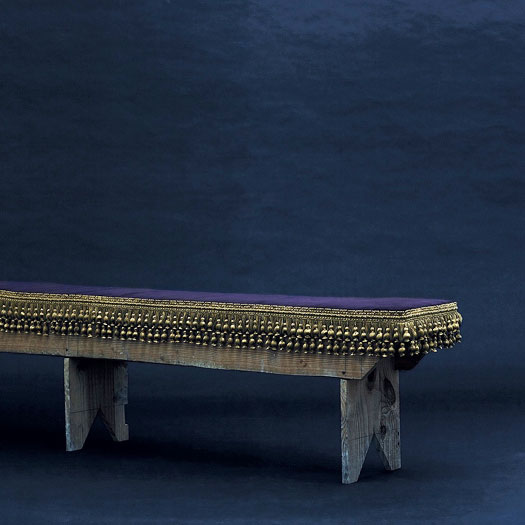
Banco Luizao Quinze (Louis XV Bench), StudioMK27's interpretation of an ad-hoc furniture piece built for a construction site in São Paulo. Photos: Reinaldo Coser, Gabriel Arantes
For the past two years, the architects of StudioMK27 — a small design firm in São Paulo, Brazil, led by Marcio Kogan — have been collecting examples of a little-known custom in their city: the making of temporary furniture by construction workers for their own use onsite. Such pieces are produced with surplus wood from the building materials and are typically discarded at the completion of the project or reused at another site in São Paulo.
Despite — or perhaps because of — their hasty fabrication from leftover wood, the pieces reveal an “amazing constructive intelligence,” said MK27 architect Mariana Simas. From their own project sites in São Paulo, Simas and her colleagues selected tables, benches, stools, chairs and shelves, and proceeded to make small modifications to them, or “grafts.” To contrast with the rusticity of the wood and the handmade method of production, they added rich materials and touches of industrial precision: a red enamel drawer slides out of a side table; a velvet, gold-tasseled cushion tops a long bench; stainless-steel casters turn a shelving unit into a rolling bar. Even as the designers established this visual contrast, the closeness of the Portuguese words luxo (luxury) and lixo (rubbish) was not from their minds, Simas said.
The finished pieces, 16 in total, were exhibited in late March at a high-end São Paulo boutique, Micasa. They are not for sale, but MK27 will create, on request, as many as three variations of each piece, which will retail from between $2,000 and $15,000. For these variations, the studio will continue to repurpose found pieces rather than commission workers to make them. When the workers first noticed the architects’ interest in their furniture, Simas recalled, they began to make pieces specifically for them, using different, more deliberate techniques. “We had to explain to them that the way they do it is what interests us the most, the spontaneous way,” she said. Because most of the pieces are crafted anonymously, the workers won’t profit from their eventual sale.
According to Simas, the project sparked debate inside the office, and some architects worried about accusations of exploiting the workers. But the desire to extend the functional life of these usually ephemeral objects, and to celebrate an authentic vernacular design tradition, won out.



Comments [6]
04.08.10
11:33
Although the logistical issue of remunerating anonymous workers is understandable, part of the profits could at least be donated to some kind of charity that might indirectly benefit their communities.
That this work comes from a Brazilian design studio is all the more exasperating: given the rampant economic disparity in Brazil, these designers should know better than to profit off the labor of people who likely earn less than $300/month. Any attempt to sell this furniture without a viable means of compensating the workers is unconscionable.
04.08.10
03:06
04.08.10
05:38
The stuff featured here is the sort of opportunist, vacuous "nouveau design povero" the bien-pensant design world (and the gallerists and collectors it feeds on) expects Brazilian designers to deliver—even when the Campana Brothers or the Gémeos street artists seem by now to have exploited the full extent of that gold mine.
It's like construction workers in other countries don't build their own benches and tables, or 'vernacular design' is something exclusive to Brazil. You know what? It's not.
If you do want to go beyond the "Favela Factor", pay homage to "stuff poor Brazilians make" and talk about vernacular design (a kind of approach I would expect from DO), try going back to the research and writings by Lina Bo Bardi, an Italian-Brazilian architect who championed Brazilian folk art and the inventiveness of its people (particularly in Northeastern Brazil). You can start with her influential book "Tempos de Grossura".
This would help you tell how the last image in the slideshow is itself an homage to Bo Bardi. It's called Bo for a reason: it seems to be a "vernacular" riff on her vernacular furniture-inspired"Girafa" chair, a true Brazilian design classic. So instead of gold nails or other fancy add-ons, here StudioMK27 attached two bits of wood to the workers' stool, adding value to a seemingly worthless piece of furniture by employing formal and historic reference. This Benchette thus goes farther than making luxo from lixo to become an insider joke within the same bien-pensant design world Marcio Kogan and his team are wishing to address. Or does it? Is this a conscious contribution to a sort of design feedback loop or were the architects just looking for an easy, clever way to make and sell an expensive Benchette? Posing such a question and beckoning discussion around these designs, not just rehashing a press-release and attaching some unresolved architect ethic dilemma to it, would be something I'd expect to read here.
04.11.10
03:51
04.13.10
01:45
04.27.10
01:07